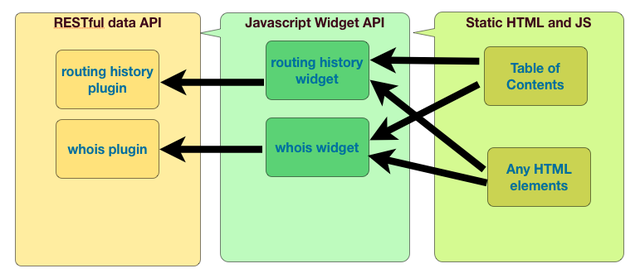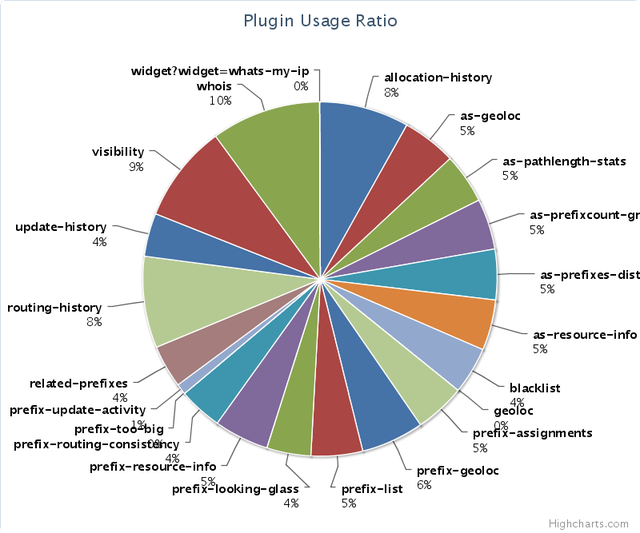The first RIPEstat demo for 2012 was released on Tuesday, 24 January. The presentation highlighted new developments involving the widget API, the data API, the web application architecture, and performance monitoring and improvement.
The first RIPEstat demo of 2012 introduced a new format as described in another RIPE Labs article. The demo is available as a video , as slides , and as a summary (this article). New feedback options , details about the next demo , and links to previous demos can be found at the end of the article.
Introduction to RIPEstat
RIPEstat is a modular and extendable toolbox designed as a single point of access to Internet-related data from RIPE NCC and other sources. It is a work in progress, and is being developed iteratively. Feedback from users helps determine the direction of development. Regular demos provide information about new functionality.
New Features
This demo introduced the RIPEstat widget and data APIs, described the architectural changes made to accommodate them, and provided details about performance monitoring and improvements.
The new APIs make RIPEstat more user-friendly by providing increased opportunities for customisation and adaption to specific needs.
Widget API
The widget API allows you to embed RIPEstat plugins in your own website. With a snippet of JavaScript - such as the one shown in the example below - it is possible to incorporate a RIPEstat element in any HTML website.

There are customisable elements of the layout, and it is possible to manipulate the widget after rendering. Several existing RIPEstat plugins are available as widgets: network-info , prefix-overview , as-overview , whois , and as-path-length . They can be seen on the RIPEstat website , where they have replaced the original plugins. There are also two new widgets: whats-my-ip and network-info .
Some small changes have been made to the plugins. The grab link provides the JavaScript for embedding the widget in another page. The source data link shows the data API call which was used, the data returned by the call, and offers download options. Permalink leads back to RIPEstat, and recreates the current state of the widget. Info replaces methodology as the means of getting further information about how the data was collected and processed.
For more information, look at the widget API documentation , or watch the more detailed demonstration in this month's demo video.
Because the widget API is in beta testing, the RIPEstat development team is interested in your feedback. If you are making use of the widget API, please tell us about it!
Data API
The new data API allows you to directly access data processed by RIPEstat through a RESTful interface over HTTP. It can return RIPEstat data in various formats (presently only JSON is implemented). The widget API uses the data API. The data API documentation describes this interface in more detail.
We are interested in hearing both your views on the data API, as well as examples of how you are making use of it.
Web Application Architecture
Creating the widget and data APIs inspired a change in the architecture of the RIPEstat web site. This makes RIPEstat a user of the services it provides: the data API supports the widget API, which in turn makes the static HTML and JavaScript webpage possible. Anyone can build applications using the same functionality.

Performance Monitoring and Improvements
The RIPEstat team has been monitoring usage and performance in order to raise understanding of how plugins are used and address performance bottlenecks. Statistics on the plugin usage ratio (Figure 3); query volume, including caching ratio; and average response times (Figure 4) have been collected.

Figure 3: Resources used per plugin as a proportion of total resource use
Several plugins were migrated to a new back-end data cluster, resulting in significant performance improvements.

In Figure 4 above, you can see how the average response times for several plugins has changed: the brown boxes indicate the previous response time, the green range shows the current average response time.
Upcoming Development
The widget API will continue to be developed, with more functionality to the API and more widget types on the horizon. The data API will be expanded to include more of the existing plugins, introduce services based on new back-end data (such as RIPE Atlas ), and to improve back-end performance.
Plugins will be extended with more details - where possible - such as history and granularity.
Two new plugins are on the drawing board: IPv6 capability per AS (based on data from APNIC ), and AS routing consistency.
Feedback
There are several ways in which you can offer feedback on RIPEstat:
- The comment box on the RIPEstat website allows you to post comments publicly.
- The Measurement Analysis and Tools (MAT) working group mailing list allows for more in-depth discussions.
- Private feedback can be sent to stat@ripe.net .
- The #ripestat tag on Twitter is used by RIPE NCC to discuss and announce RIPEstat.
Future Demo
The next RIPEstat demo is scheduled for release on Tuesday, 21 February 2012. It will be accompanied by an article on RIPE Labs.
Archive
Videos of previous RIPEstat demos and other RIPEstat movies are available on the RIPE NCC YouTube channel (look for the RIPEstat playlist).





Comments 0
The comments section is closed for articles published more than a year ago. If you'd like to inform us of any issues, please contact us.